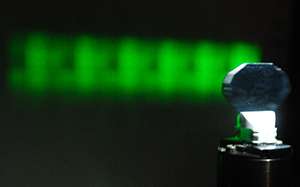Holograms set for greatness

A new technique that combines optical plates to manipulate laser light improves the quality of holograms.
Holography makes use of the peculiar properties of laser light to record and later recreate three-dimensional images, adding depth to conventionally flat pictures. Zhi Ming Abel Lum and co‐workers at the A*STAR Data Storage Institute, Singapore, have now developed a method for increasing the number of pixels that constitute a hologram, thus enabling larger and more realistic three-dimensional images1.
Holographic imaging works by passing a laser beam through a plate on which an encoded pattern, known as a hologram, is stored or recorded. The laser light scatters from features on the plate in a way that gives the impression of a real three-dimensional object. With the help of a scanning mirror, the system built by Lum and his co-workers combines 24 of these plates to generate a hologram consisting of 377.5 million pixels. A previous approach by a different team only managed to achieve approximately 100 million pixels.
The researchers patterned the plates, made of a liquid-crystal material on a silicon substrate, with a computer-generated hologram. Conventionally, holograms are recorded by scattering a laser beam off a real object. "Holograms can also be mathematically calculated," explains Lum. "This avoids problems, such as vibrations, associated with the conventional recording method that may reduce the quality of the final reconstructed image."
Each plate, also called a spatial light modulator (SLM), consisted of an array of 1,280 by 1,024 pixels—1.3 million in total. Simply stacking the plates to increase the total number of pixels, however, created 'optical gaps' between them. As a workaround, the researchers tiled 24 SLMs into an 8 by 3 array on two perpendicular mounting plates separated by an optical beam splitter. They then utilized a scanning mirror to direct the laser light from the combined SLM array to several predetermined positions, just as if they had all been stacked seamlessly together (see image).
The team demonstrated that by shining green laser light onto this composite holographic plate, they could create three-dimensional objects that replayed at a rate of 60 frames per second in a 10 by 3-inch (25 by 7.5-centimeter) display window.
This relatively simple approach for increasing the pixel count of holograms should help researchers develop three-dimensional holographic displays that are much more realistic than those commercially available at present. "Our next step is to improve this 'tiling' approach to further scale up the number of pixels of the hologram, which will lead to a larger holographic image," says Lum.
More information: Lum, Z. M. A., Liang, X. A., Pan, Y. C., Zheng, R. T. & Xu, X. W. Increasing pixel count of holograms for three-dimensional holographic display by optical scan-tiling. Optical Engineering 52, 015802 (2013). dx.doi.org/10.1117/1.OE.52.1.015802



















